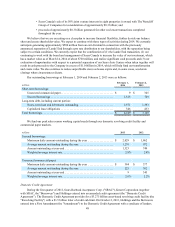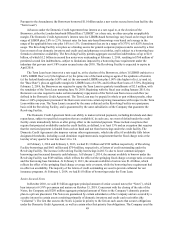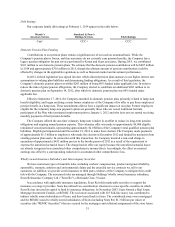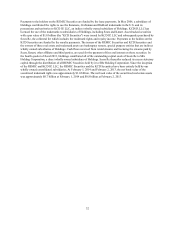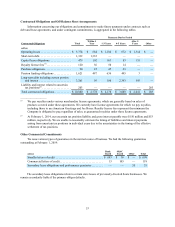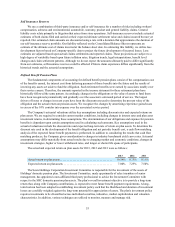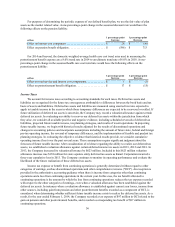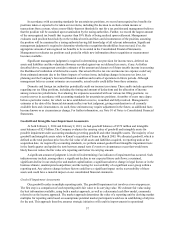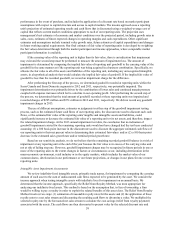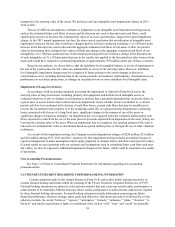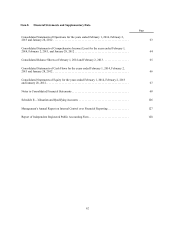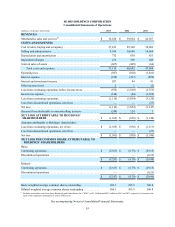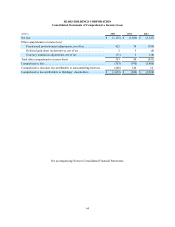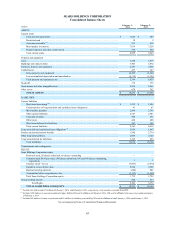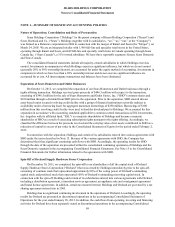Sears 2013 Annual Report Download - page 58
Download and view the complete annual report
Please find page 58 of the 2013 Sears annual report below. You can navigate through the pages in the report by either clicking on the pages listed below, or by using the keyword search tool below to find specific information within the annual report.58
performance in the event of purchase, and includes the application of a discount rate based on market participant
assumptions with respect to capital structure and access to capital markets. The income approach uses a reporting
unit's projection of estimated operating results and cash flows that is discounted using a weighted-average cost of
capital that reflects current market conditions appropriate to each of our reporting units. The projection uses
management's best estimates of economic and market conditions over the projected period, including growth rates in
sales, costs, estimates of future expected changes in operating margins and cash expenditures. Other significant
estimates and assumptions include terminal value growth rates, future estimates of capital expenditures and changes
in future working capital requirements. Our final estimate of fair value of reporting units is developed by weighting
the fair values determined through both the market participant and income approaches, where comparable market
participant information is available.
If the carrying value of the reporting unit is higher than its fair value, there is an indication that impairment
may exist and the second step must be performed to measure the amount of impairment loss. The amount of
impairment is determined by comparing the implied fair value of reporting unit goodwill to the carrying value of the
goodwill in the same manner as if the reporting unit was being acquired in a business combination. Specifically, we
allocate the fair value to all of the assets and liabilities of the reporting unit, including any unrecognized intangible
assets, in a hypothetical analysis that would calculate the implied fair value of goodwill. If the implied fair value of
goodwill is less than the recorded goodwill, we record an impairment charge for the difference.
After performing the first step of the process, we determined goodwill recorded at reporting units within the
Sears Canada and Sears Domestic segments in 2012 and 2011, respectively, was potentially impaired. The
impairment determination was primarily driven by the combination of lower sales and continued margin pressure
coupled with expense increases which led to a decline in our operating profit. After performing the second step of
the process, we determined that the total amount of goodwill recorded at these reporting units was impaired and
recorded charges of $295 million and $551 million in 2012 and 2011, respectively. We did not record any goodwill
impairment charges in 2013.
The use of different assumptions, estimates or judgments in either step of the goodwill impairment testing
process, such as the estimated future cash flows of our reporting units, the discount rate used to discount such cash
flows, or the estimated fair value of the reporting units' tangible and intangible assets and liabilities, could
significantly increase or decrease the estimated fair value of a reporting unit or its net assets, and therefore, impact
the related impairment charge. At the 2013 annual impairment test date, the conclusion that no indication of
goodwill impairment existed for the remaining reporting units would not have changed had the test been conducted
assuming: (1) a 100 basis point increase in the discount rate used to discount the aggregate estimated cash flows of
our reporting units to their net present value in determining their estimated fair values and/or (2) a 100 basis point
decrease in the estimated sales growth rate and/or terminal period growth rate.
Based on our sensitivity analysis, we do not believe that the remaining recorded goodwill balance is at risk of
impairment at any reporting unit at the end of the year because the fair value is in excess of the carrying value and
not at risk of failing step one. However, goodwill impairment charges may be recognized in future periods in one or
more of the reporting units to the extent changes in factors or circumstances occur, including deterioration in the
macroeconomic environment, retail industry or in the equity markets, which includes the market value of our
common shares, deterioration in our performance or our future projections, or changes in our plans for one or more
reporting units.
Intangible Asset Impairment Assessments
We review indefinite-lived intangible assets, primarily trade names, for impairment by comparing the carrying
amount of each asset to the sum of undiscounted cash flows expected to be generated by the asset. We consider the
income approach when testing intangible assets with indefinite lives for impairment on an annual basis. We
determined that the income approach, specifically the Relief from Royalty Method, was most appropriate for
analyzing our indefinite-lived assets. This method is based on the assumption that, in lieu of ownership, a firm
would be willing to pay a royalty in order to exploit the related benefits of this asset class. The Relief from Royalty
Method involves two steps: (1) estimation of reasonable royalty rates for the assets and (2) the application of these
royalty rates to a net sales stream and discounting the resulting cash flows to determine a value. We multiplied the
selected royalty rate by the forecasted net sales stream to calculate the cost savings (relief from royalty payment)
associated with the assets. The cash flows are then discounted to present value by the selected discount rate and


